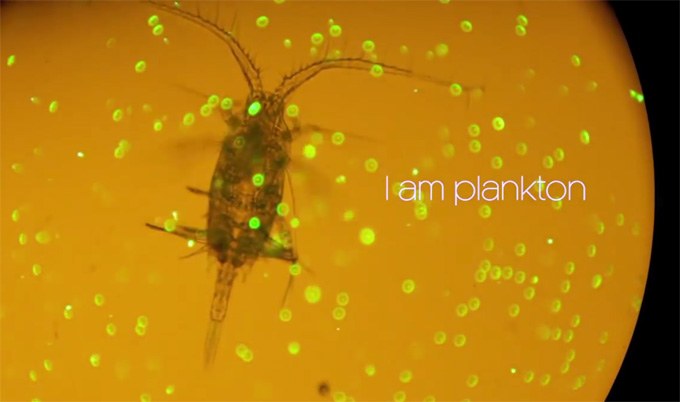Researchers have known for a few years that zooplankton can eat microplastics. Take for example, this really great video of various laboratory zooplankton gobbling up fluorescent-dyed microplastics.
Scientists have now positively identified microplastics in a considerable percentage of wild zooplankton, showing for the first time this phenomenon is more than a scary theory but rather is undeniably a very serious real-world concern. What this finding tells us is that every animal up the food chain are eating toxic plastics too. Corals, fish, whales, birds, bears, and yes, ultimately humans too.
And then there’s also the issue of microplastics in our aquariums … 
From the Vancouver Aquarium Marine Science Centre:
Microplastics entering ocean food web through zooplankton, researchers find
Tiny microscopic animals called zooplankton are ingesting plastic particles at an alarming rate, according to a new study by Dr. Peter Ross, head of the Ocean Pollution Research Program at Vancouver Aquarium Marine Science Centre. That could spell trouble for the entire aquatic food web.
In a scientific paper released June 12 in the international journal Archives of Environmental Contamination and Toxicology, Dr. Ross and his co-authors, Jean-Pierre Desforges and Moira Galbraith, report on microplastic particles found in two key species of zooplankton found in the Northeast Pacific Ocean: copepods and euphausiids. The findings show plastic in one out of every 34 copepods, and in one in every 17 euphausiids. It’s the first indisputable evidence that species at the bottom of the food web are mistaking plastic for food, which raises troubling questions about species that rely on these invertebrates for food, such as B.C. salmon.
“Zooplankton represent a critical energy source in the world’s oceans and a vital food for many fish and marine mammal species. Most salmon species feed heavily on copepods and euphausiids during their juvenile and adult life stages. The potential transfer of microplastics in the food web, from zooplankton to Pacific salmon that ingest them, would be a great concern given the importance of salmon in our regional ecosystems,” said Dr. Ross. “These particles could pose a serious risk of physical harm to the marine animals that consume them, potentially blocking their gut or leaching chemicals into their bodies.”
Microplastics refer to barely visible litter in the form of small fragments, fibres and granules. They may be deliberately manufactured, as is the case with microbeads in exfoliants or toothpastes, or may result from the breakdown of larger pieces of plastic or textiles. The microplastics found in the zooplankton in this study consisted of small fragments and fibers, but not the deliberately designed microbeads that may sink to the sediments in the ocean.
The study focused on four major areas in coastal B.C.: Strait of Georgia, west coast Vancouver Island, northern Vancouver Island/Haida Gwaii and offshore Pacific. The highest concentrations observed were in the Strait of Georgia for both species of zooplankton. “We believe microplastic ingestion by zooplankton to be a bigger problem near urban areas,” Dr. Ross noted.
The authors estimate using findings in zooplankton that juvenile salmon in the Strait of Georgia may be ingesting two to seven microplastic particles per day, and returning adult salmon are ingesting up to 91 particles per day. The Strait of Georgia is a crucial feeding ground for salmon, notably tiny smolts as they migrate out to the ocean.
Dr. Ross’ team also notes the data can be used to estimate what larger marine mammals might ingest based on their feeding rates on zooplankton. Using this method, they estimate a humpback, which is a baleen whale, could ingest more than 300,000 microplastic particles per day.
In order to measure the presence of microplastics, zooplankton samples were collected and placed in glass-coated polypropylene well plates and immersed in nitric acid. The plates were then covered and heated, until all the tissue of the zooplankton was digested by the hot acid. The only things remaining behind were then examined under a microscope for the presence of microplastics.
This study follows on Dr. Ross’ report last year of widespread contamination of seawater in the Northeast Pacific Ocean. He joined the Vancouver Aquarium in 2014 to launch its Ocean Pollution Research Program, which conducts international-caliber scientific research on pollution, ranging from marine debris to the impact of hydrocarbons on the coastal environmental. The Ocean Pollution Research Program is part of the Vancouver Aquarium’s Coastal Ocean Research Institute.
Journal Reference: Jean-Pierre W. Desforges, Moira Galbraith, Peter S. Ross. Ingestion of Microplastics by Zooplankton in the Northeast Pacific Ocean. Archives of Environmental Contamination and Toxicology, 2015; DOI: 10.1007/s00244-015-0172-5











0 Comments